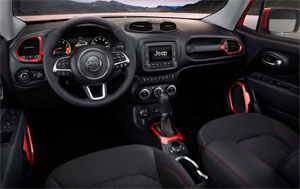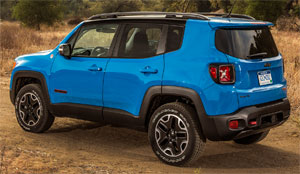2015 Jeep Renegade
While we as automotive enthusiasts tend to be wary of returning nameplates, as they rarely live up to the cars that originally used them, it can be done with success, as jeep proved with the new cherokee. Well, with that success in hand, jeep is now focused on the rapidly growing small crossover segment, and has placed the venerable Renegade name on an new model, with a new DNA.
Renegade is defined as “one who deserts or betrays an organization.” So it’s a fitting nameplate for the 2015 Jeep Renegade, as it enters into a new segment for brand, and is clearly unlike any other jeep in the stable… …or is it?
Jeep fans know that renegade not as a model name, but rather a trim package found mostly on cjs and wranglers.
And while early photos, with its borderline-cartoonish appearance, made it hard to take seriously, in person, the subcompact renegade sports much better proportions while still saying classic jeep up front. But, less so in the rear ¾ view with the upwardly arched quarter windows. But, the x-motif in the taillights and elsewhere, playing off a ww II-style fuel can, is pretty cool.
As for its new DNA, the renegade is on fiat’s small-wide 4x4 platform that it shares with the 500l and upcoming 500x. Built in Italy, FCA hopes renegade will make jeep as popular in global markets as it is here.
 One feature we haven’t seen on other new smallish-utes is removable roof panels. Renegade’s basic mysky system has two separate pieces that, when taken off, deliver some of that open air experience jeeps are known for. Mysky with a power sliding front panel is also available.
One feature we haven’t seen on other new smallish-utes is removable roof panels. Renegade’s basic mysky system has two separate pieces that, when taken off, deliver some of that open air experience jeeps are known for. Mysky with a power sliding front panel is also available.
There’s not an abundance of room in the comfortable front seats, but more than you’re expecting; and that just means all of the controls fall close to hand.
Seat controls were manual in our latitude-trimmed tester, but they’re very beefy felling, not compact car flimsy. The instrument panel looks nice, if a bit gimmicky. there’s jeep logos and “since 1941” script everywhere. It can get a bit cheesy and some materials are more economy than rugged.
The uconnect screen is on the small side, but it gets the job done, and the overall look of the interior will undoubtedly appeal to the younger set. Rear seat room is good, but the seatbacks don’t quite fold flat for cargo.
And while total cargo space is decent at 50.8 cubic-ft; 18.5 behind the rear seats; it falls well short of the Honda HR-V. Also, the mysky panels storage bag takes up a lot of floor space.
Now, jeep wanted to make sure you can still do jeep-type things in the renegade, and the trailhawk model features a standard active drive low 4x4 system with terrain select modes for snow, sand, mud, and rock. It’s clearly the only suncompact ute designed for true off-road use.
 And you can still get jeep’s regular-strength active drive full-time 4x4 system in all other trims, which worked fine for us.
And you can still get jeep’s regular-strength active drive full-time 4x4 system in all other trims, which worked fine for us.
On road, the renegade feels very car-like, with minimal roll in corners and heavy steering. It’s a solid package overall, with no squeaks or rattles from the roof panels, though wind noise can ring out at speed.
As for powertrains, there are two. The larger, 2.4-liter tigershark I4 boasts 180-horsepower, and 175 lb-ft. of torque. Though a little rough at idle, there’s an impressive amount of power for a segment that mostly consists of sub-2.0-liter engines.
And of course there is one of those available here as well, fiat’s 160-horsepower 1.4-liter multiair turbo-4 which comes with a 6-speed manual.
The 2.4-liter gets a 9-speed automatic which worked okay. There’s still some occasional stumbling, but it’s definitely an improvement over early cherokees.
At our test track, the 2.4 renegade snaps off the line like a sprinter, but quickly settles down into a marathon pace; reaching 60 in 8.6-seconds. Leisurely shifts compound the ¼-mile situation, which took 16.5-seconds to climb to 83 miles-per-hour.
 A relaxed pace was the way to go through our cone course too; as anything more, turns manageable understeer into full-on plow. An average stopping distance of 120-feet from 60 was not bad, but random locking and an unsettled rear needs to be improved upon.
A relaxed pace was the way to go through our cone course too; as anything more, turns manageable understeer into full-on plow. An average stopping distance of 120-feet from 60 was not bad, but random locking and an unsettled rear needs to be improved upon.
Government fuel economy ratings for a 2.4 4x4 are 21-city, 29-highway, and 24-combined. Our average of 25.4 of regular is certainly superior to an old xj; but we expected better from such a small-fry. Still the energy impact score of 13.7-barrels of oil use and 6.1-tons of annual CO2 emissions is healthier than average.
We think jeep’s first attempt at a truly global small crossover will represent the brand well throughout the world, as it will be available in more than 100 countries. Pricing here in the good old U.S. of America starts at $18,990 for a sport; 4-wheel-drive adds 2-grand more.
So, while its origins are off-shore, the 2015 Renegade still embodies much of what has made the jeep brand an American icon. Combined with a low price, it’s the perfect jeep for people who think they want a jeep, but really want a rugged-looking small crossover with all of the modern comforts they’ve become accustomed to. so, renegade is one traitor with a good cause.
Specifications
- Engine: 2.4 liter / 1.4-liter
- Horsepower: 180 / 160
- 0-60 mph: 8.6 seconds
- 1/4 mile: 16.5 seconds @ 83 mph
- EPA: 21 mpg city/ 29-highway
- Energy Impact: 13.7 barrels of oil/yr
- CO2 Emissions: 6.1 tons/yr
2025 Volkswagen ID. Buzz
Volkswagen Brings Beetlemania Level Of Excitement To Minivan Segment
The duty of upholding Volkswagen’s heritage has most recently been delegated to small legacy car names like Golf and Jetta. But hold on! A much larger, totally modern take on VW’s classic microbus has just buzzed over the horizon— the all-electric ID. Buzz. It’s been at the top of our minds since we first saw the concept back in 2017. Well, it’s finally here, so let’s get our groove into drive!
This 2025 Volkswagen ID. Buzz has indeed created the most buzz around Volkswagen since the Beetle’s return to the U.S. in the late 1990s. We couldn’t drive it anywhere without drawing a crowd. No wonder, just about everyone has a VW Microbus story to tell, and seeing this reimagined version rolling down the street brings back all those memories.
VW really pulled it off as far as we’re concerned, as it looks great without appearing over the top. All the cues are here: Big VW logo front and center, lots of greenhouse including A-pillar windows and mini sliders for the second-row passengers, D-pillar air vents, and two-tone wheels. And while its appearance may be pure retro, its drivetrain is far from it, as the ID. Buzz is all-electric, and unlike the new Beetle, the Buzz does retain the original Microbus’ rear-drive architecture.
Powering those rear wheels is a 210-kW motor drawing juice from a 91-kWh battery for a range of 234 miles; 200-kW max charging will get you to 80% in about 26 minutes. Buyers can add another small 80-kW motor up front for 4motion all-wheel-drive and an increase of total output from 282 to 335 horsepower with a combined 512 lb-ft of torque. It uses the same battery, but range estimates drop just slightly to 231 miles. But while those numbers are modest, we also found them to be quite conservative, as we observed as many as 287 miles available in our all-wheel-drive tester’s gauge display and were on pace for 273 miles in our driving loop.
One throwback theme that may be a turnoff to some is that it’s quite a step up into the Buzz’s front seats, but there’s certainly a commanding view of the road once you climb in. Second row seating can be either a three-place bench or a pair of captain’s chairs, so there’s generous room for seven or six passengers. The captain’s chairs in our Pro S Plus offer good support and very easy access to the third row.
Lots of flexibility too with the option to simply fold the seats or remove them altogether.
With the sliding side doors and a wide opening rear hatch, there’s plenty of access for loading big sport utility amounts of cargo. Lots of flexibility too with the option to simply fold the seats or remove them altogether, and the ability to create a full-length flat floor with a rear cargo shelf that covers some handy removable storage bins. There’s 18.6 cubic-feet of space behind the third row, 75.5 behind the second, and a max of 145.5. That’s more than a Chevrolet Tahoe. For smaller items, there are lots of cubbies throughout the cabin, along with a standard Buzz Box that can be moved to multiple locations.
With a design that prioritizes retro form and modern function over aero efficiency, the 4motion equipped ID. Buzz earns a Fair efficiency rating, using 42-kWh of electricity per 100 miles, and we weren’t sure what to expect at our Mason Dixon test track.
What we found was great torque off the line and drama free launches to 60 in just 5.3 seconds. It was very stable at speed and power delivery stayed steady most of the way down the track until we reached about 90 mph, when it began to taper off just before we finished the quarter-mile in 14.0 seconds flat at 97 mph.
With 1,200-lbs. of battery weight nestled in its 127.5-inch wheelbase, the Buzz felt planted to the pavement through our handling course. There was quite a bit of body roll to deal with, but surprisingly little understeer. In panic braking runs, pedal response was inconsistent, feeling soft at times, pushing back hard at others; but through it all, results were quite good, stopping from 60 in an average of just 108 feet.
Three interior themes are available, this Dune is the brightest, featuring coastal inspired wood optic dash décor, “gray and clay” leatherette surfaces, and a high-mounted central 12.9-inch touchscreen. Pricing starts with a rear-wheel-drive Pro S at $61,545; this Pro S Plus begins at $65,045, add another $4,500 for 4motion, which brings a few extra features along with all-wheel drive.
Retro design with old-school VW charm, modern EV drivetrain, big SUV capacity merged with minivan flexibility; it all comes together in this 2025 Volkswagen ID. Buzz. It’s easily one of the coolest rides of the year and one that will likely keep Volkswagen dealers buzzing for years to come, and that’s something no other people and things mover can say.
Specifications
As Tested
- Motor Setup: Dual-Motor AWD
- Battery Size: 91-kWh
- Horsepower: 335
- Torque: 512 lb-ft
- EPA Range: 231 miles
- 0-60 mph: 5.3 seconds
- 1/4 Mile: 14.0 seconds at 97 mph
- Braking, 60-0: 108 feet
- MW Test Loop: ~ 273 miles













































